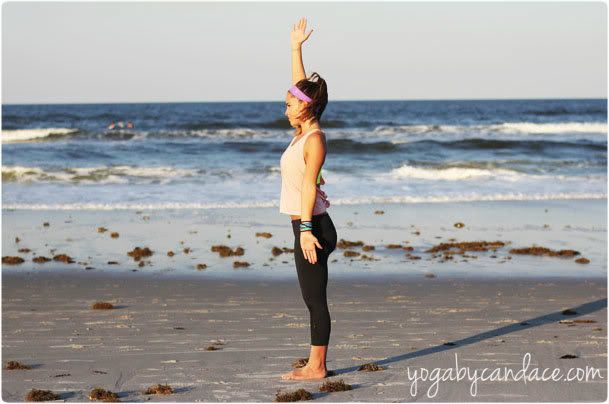Dancer's pose, or natarajasana in Sanskrit, is one of my favorite poses. There are so many ways to express the pose- some people point their extended arm to the sky while others stretch it out in front of them; some keep their torsos parallel to the ground while others keep it more erect. There's really no "wrong" way to do the pose. As long as you make sure your alignment is in check, don't worry if you see it done multiple ways. Here's how I like to do dancer's:
Step 1: Set the foundation in tadasana- mountain pose. Stand tall, feet together. Tuck the tail bone under slightly for a long spine. Shoulders back, collar bones broad. Engage the knee caps. Look straight ahead and find a drishti. Focus on that one point and breathe.

Step 2: Inhale the right arm to the sky and turn your left palm away from you with a counter clockwise rotation. Without actually moving, shift your weight into your right leg.
 Step 3: As you exhale, bend your left knee behind you, reaching the heel of your left foot to your left buttocks. Keeping your left palm away from you, grab the arch of your left foot. The left hand is really important, so make sure the palm is away from you and you're grabbing the arch of the foot. Once you're in this position, breathe. For some of you, this might be enough of a sensation and you may want to stay right here, breathing and lengthening. If you're not at your edge here, then move on to the third step:
Step 3: As you exhale, bend your left knee behind you, reaching the heel of your left foot to your left buttocks. Keeping your left palm away from you, grab the arch of your left foot. The left hand is really important, so make sure the palm is away from you and you're grabbing the arch of the foot. Once you're in this position, breathe. For some of you, this might be enough of a sensation and you may want to stay right here, breathing and lengthening. If you're not at your edge here, then move on to the third step:

Step 4: As you inhale, gaze at your drishti and send your body forward, right arm extended out in front of you. Kick your left leg up behind you and push out of the ball of the foot. Keep the right kneecap raised, and feel length from the right heel all the way through the ball of the left foot. Keep with your breath here, making sure your right arm and hand are energized. Quiet expression, full breath. After five to ten breaths, come out as gracefully as you went in and repeat on the other side.
Benefits: Improves balance. Stretches the arms and chest. Stretches the thighs, groins, and abs.
Tips: Use your drishti! Having that focal point is so important to balancing in this posture. One thing that helps me is keeping the back leg active. If I try to raise the leg and it's limp, I fall without fail. When it is energized and the muscles are engaged, the pose comes easier.
